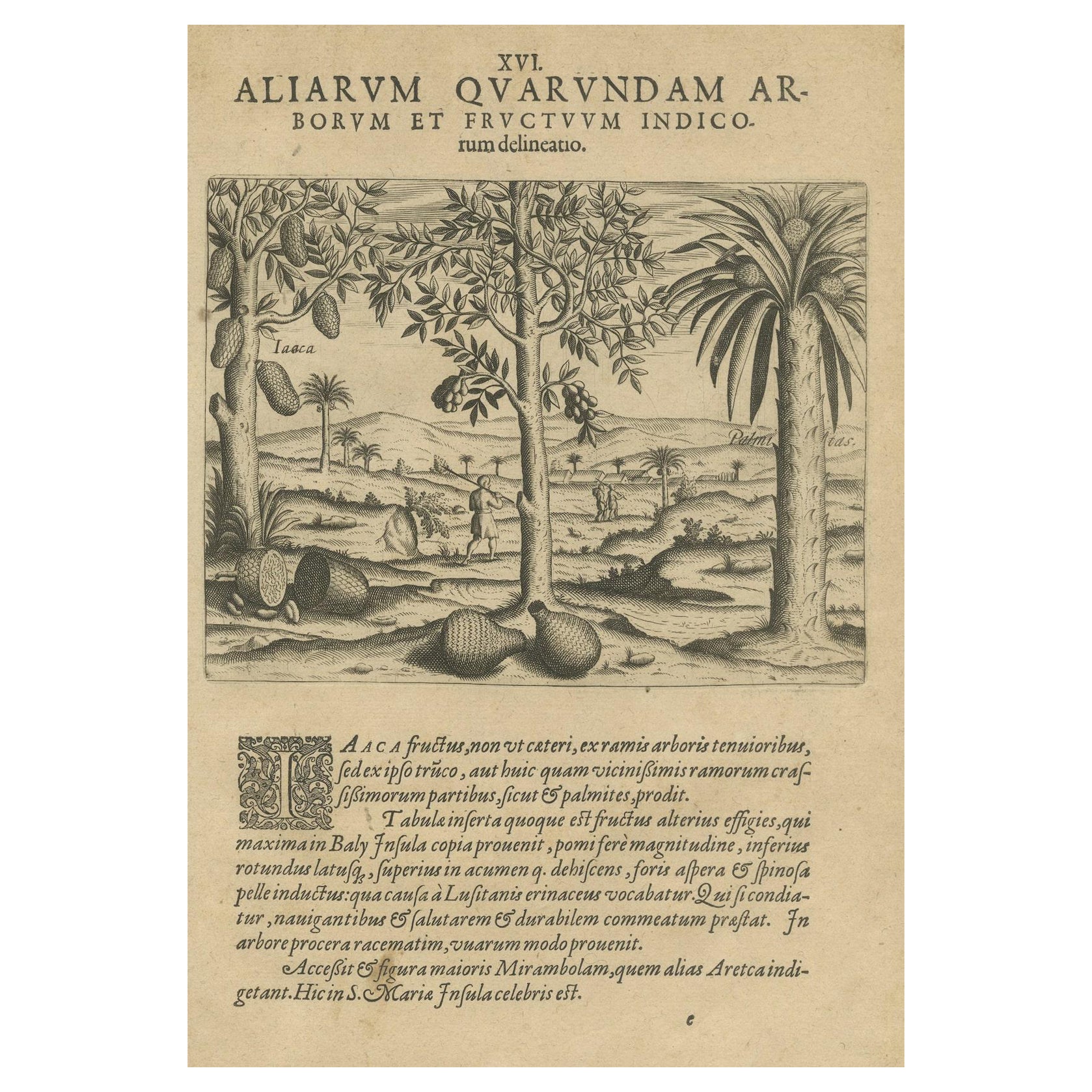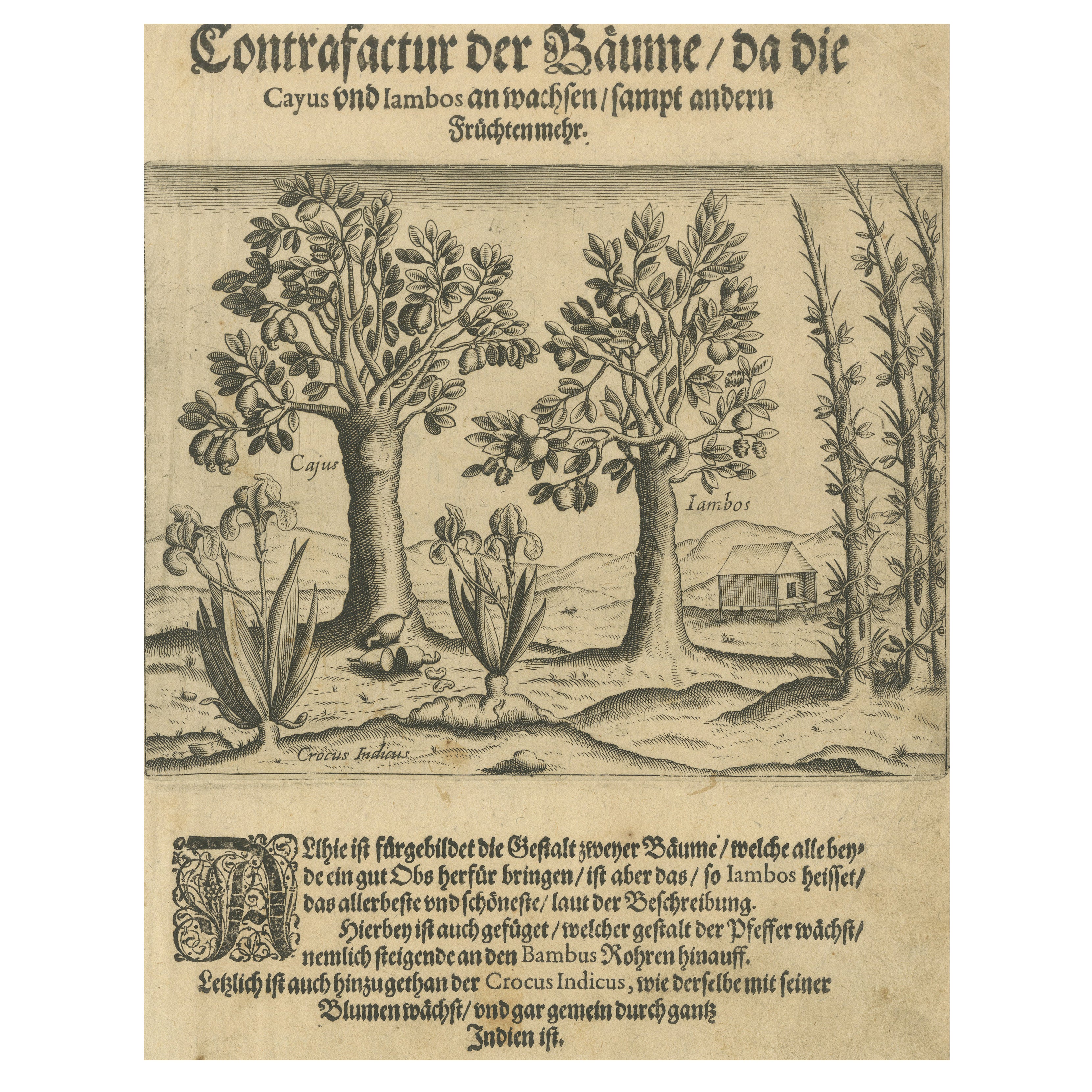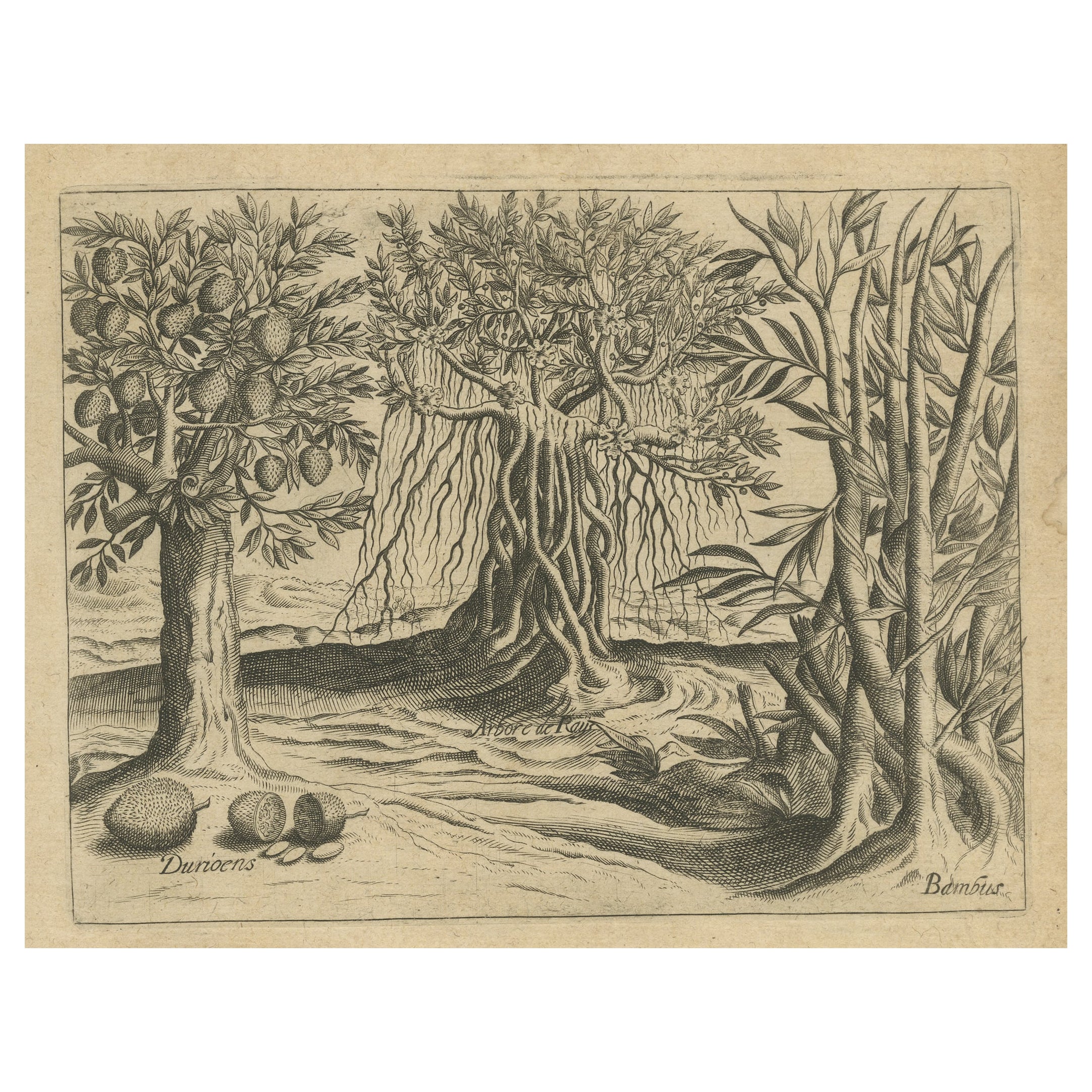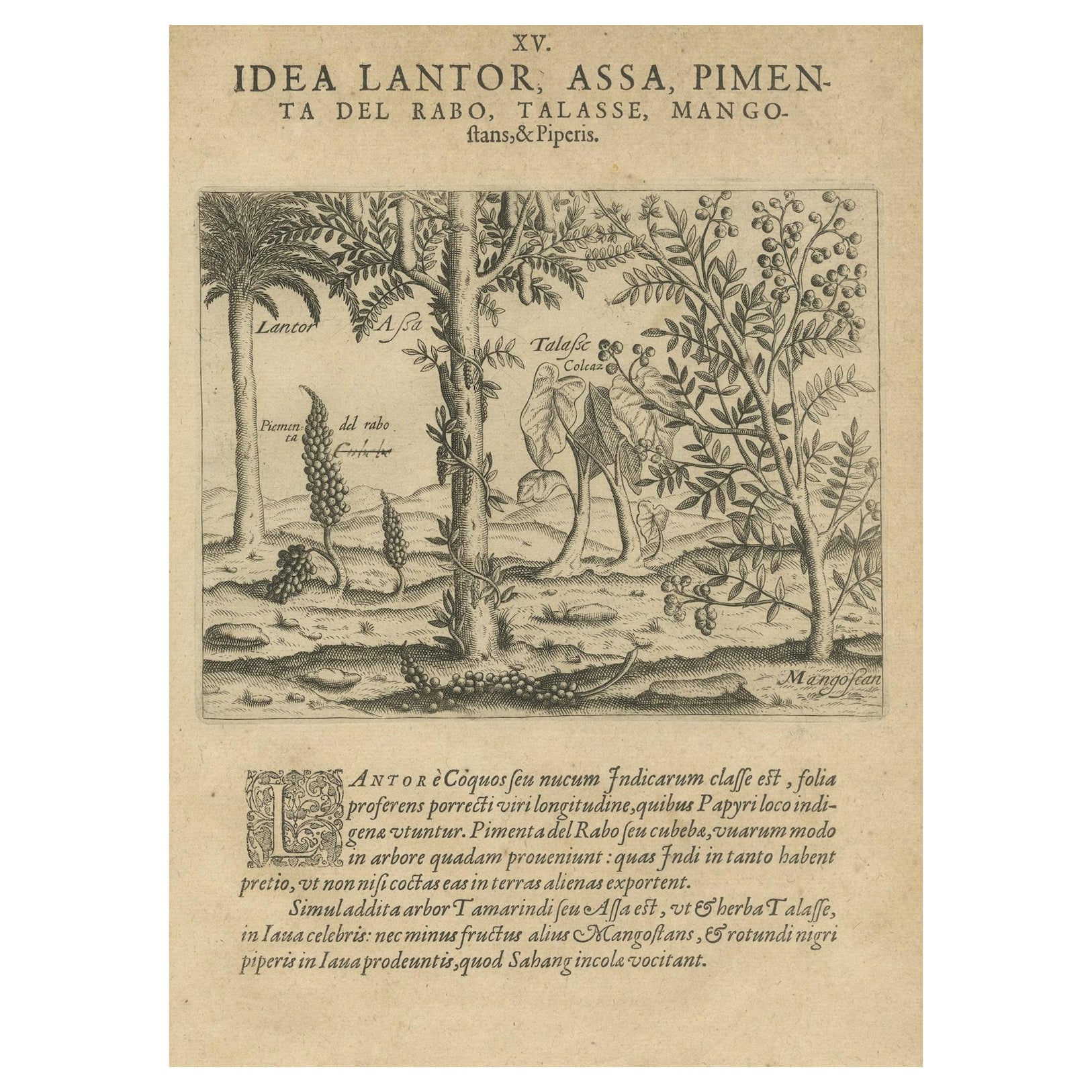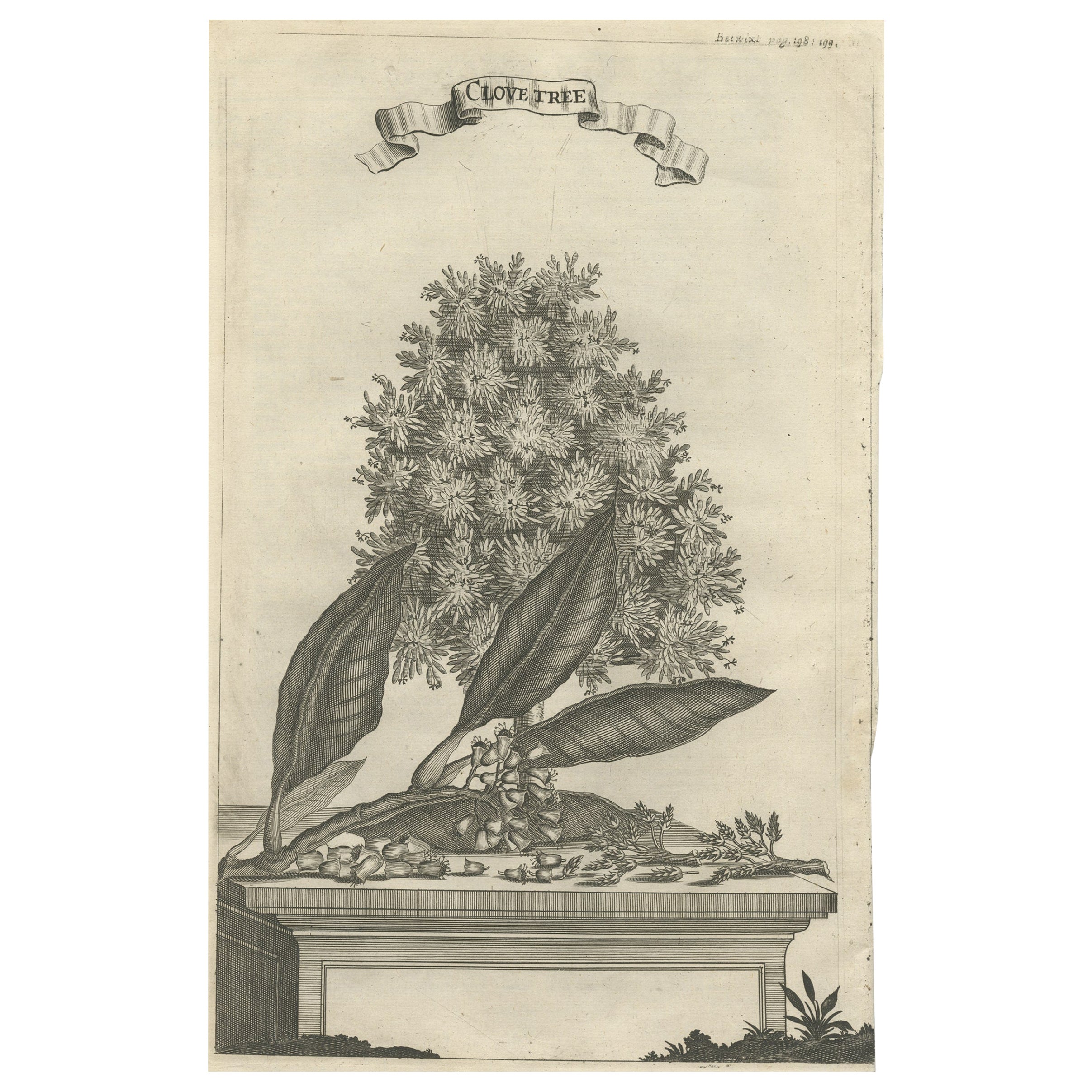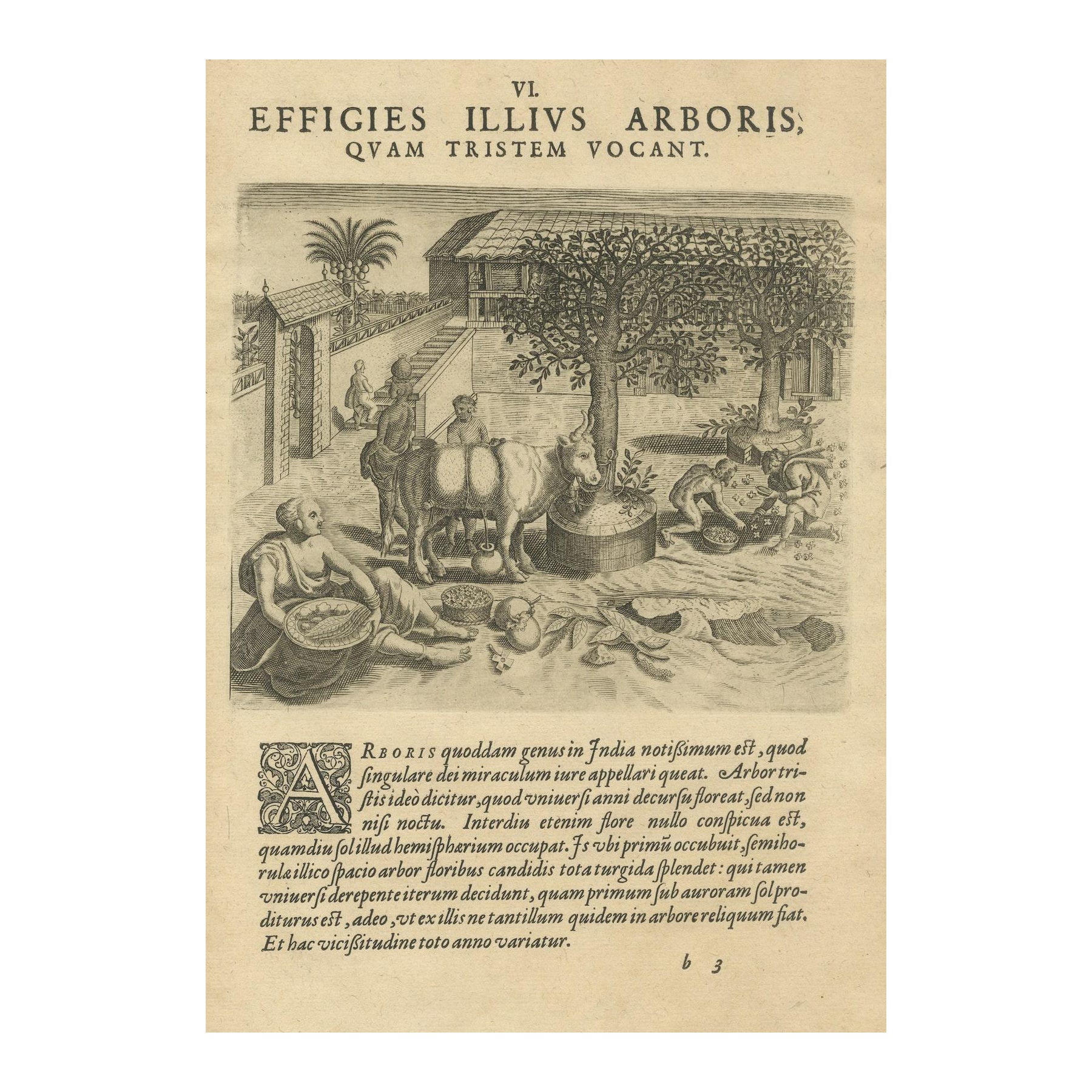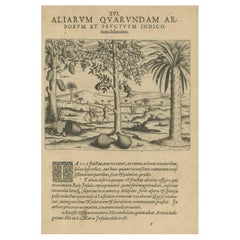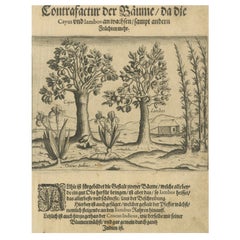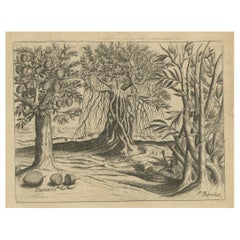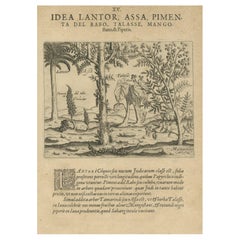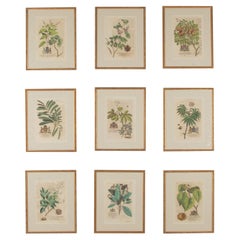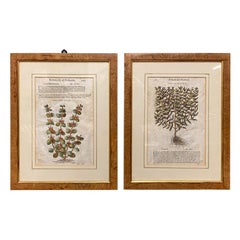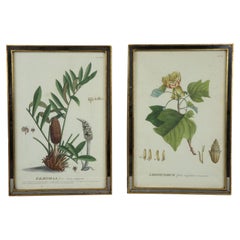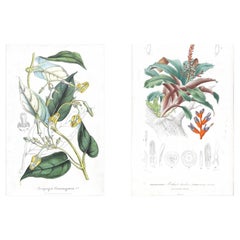Items Similar to Exotic Flora of the Indies: The Cajus and Jambos Trees Copper Engraved in 1601
Want more images or videos?
Request additional images or videos from the seller
1 of 10
Exotic Flora of the Indies: The Cajus and Jambos Trees Copper Engraved in 1601
$587.97
£433.60
€490
CA$811.98
A$890.93
CHF 466.27
MX$10,964.37
NOK 5,874.34
SEK 5,502.19
DKK 3,731.95
About the Item
Title: "Exotic Flora of the Indies: The Cajus and Jambos Trees in De Bry's 1601 Engraving"
Description: This detailed engraving by Theodore de Bry, dating back to 1601, beautifully illustrates two tropical trees, the Cajus and the Jambos, both renowned for their delectable fruits in the regions of India. The Cajus tree, likely referring to what is known today as the cashew, is depicted with its distinctive fruit that dangles below the swollen pedicel, commonly called the cashew apple. The Jambos tree, with its lush, dense foliage and abundant fruiting, could be related to the rose apple, known for its fragrant, rose-scented fruit.
Included in the scene is a depiction of the Indian Crocus, adding a touch of the diverse understory vegetation of the tropical climate. The image conveys a peaceful coexistence with nature, as indicated by a modest dwelling in the background, suggesting the integration of these trees into the daily lives of the local inhabitants for both nourishment and commerce.
The text is in Latin, and here is the English translation:
"In this picture, two trees are shown, each of which bears the most excellent and noble fruit. The best of these is called the Jambos, native to the region, which the inhabitants call Cayos. On this tree, nothing of note is bestowed.
Moreover, this also represents a marvelous spectacle, in which the slow-growing cane bamboo surrounds itself. Finally, the Indian Crocus has been added, which blooms with its native flower; which is widespread throughout all of India."
De Bry's engravings were pivotal in bringing the natural wealth of the New World and the East Indies to the European imagination. His work not only served as an artistic endeavor but also as an educational tool that fed the European appetite for knowledge about the vast diversity of the world's flora and fauna. This engraving, with its precision and attention to botanical detail, remains a significant historical record of the natural world as seen through the lens of the early modern European explorers.
The engraving is a page from Part IV of de Bry's "Petits Voyages," which narrates significant expeditions to the East Indies, including those led by Jan Juygen van Linschoten and Cornelis de Houtman between 1595-97, as well as the journey by Jacob van Neck and Wybrandt van Warwijck in 1598-99. These works were not merely artistic endeavors but also ethnographic records, showcasing indigenous peoples, fauna, flora, and the diverse riches of lands like India, Madagascar, and the East Indies.
Though Theodore de Bry began this ambitious project, it was continued posthumously by his family and later completed by his son-in-law, Matthaus Merian, in 1644. This particular engraving, rich in detail and drama, offers a window into the perilous and wondrous experiences of early explorers, and the ways in which these moments were captured and communicated to a European audience hungry for knowledge of the wider world.
- Dimensions:Height: 11.82 in (30 cm)Width: 7.88 in (20 cm)Depth: 0 in (0.02 mm)
- Materials and Techniques:Paper,Engraved
- Place of Origin:
- Period:Early 17th Century
- Date of Manufacture:1601
- Condition:The condition of the print is very good, considering its age of over 400 years. Light brownish toning and some soiling due to handling, mainly around the edges. Please study this image carefully.
- Seller Location:Langweer, NL
- Reference Number:Seller: BG-13596-151stDibs: LU3054337756132
About the Seller
5.0
Recognized Seller
These prestigious sellers are industry leaders and represent the highest echelon for item quality and design.
Platinum Seller
Premium sellers with a 4.7+ rating and 24-hour response times
Established in 2009
1stDibs seller since 2017
2,618 sales on 1stDibs
Typical response time: <1 hour
- ShippingRetrieving quote...Shipping from: Langweer, Netherlands
- Return Policy
Authenticity Guarantee
In the unlikely event there’s an issue with an item’s authenticity, contact us within 1 year for a full refund. DetailsMoney-Back Guarantee
If your item is not as described, is damaged in transit, or does not arrive, contact us within 7 days for a full refund. Details24-Hour Cancellation
You have a 24-hour grace period in which to reconsider your purchase, with no questions asked.Vetted Professional Sellers
Our world-class sellers must adhere to strict standards for service and quality, maintaining the integrity of our listings.Price-Match Guarantee
If you find that a seller listed the same item for a lower price elsewhere, we’ll match it.Trusted Global Delivery
Our best-in-class carrier network provides specialized shipping options worldwide, including custom delivery.More From This Seller
View AllTropical Abundance: The Jackfruit and Palm Trees in De Bry's 1601 Engraving
Located in Langweer, NL
"Tropical Abundance: The Jackfruit and Palm Trees in De Bry's 1601 Engraving"
Description: This remarkable 1601 engraving by Theodore de Bry illustrates the lush vegetation of India...
Category
Antique Early 17th Century Prints
Materials
Paper
$527 Sale Price
20% Off
Cashew and Rose Apple Trees with Pepper and Crocus Indicus – de Bry, 1600
Located in Langweer, NL
Cashew and Rose Apple Trees with Pepper and Crocus Indicus – de Bry, 1600
Exotic early engraving from Johann and Israel de Bry’s illustrated edition of Jan Huygen van Linschoten’s t...
Category
Antique Early 1600s Dutch Prints
Materials
Paper
Botanical Marvels of India: Bamboo and Durian in De Bry's 1601 Copper Engraving
Located in Langweer, NL
This 1601 engraving by Theodore de Bry, a master engraver and publisher of the late Renaissance period, depicts the flora of India with a remarkable degree of detail and artistry. The print is titled "DE ALGA SEV ARVNDINE INDICA, BAMBVS DICTA, ITEM DE arbore radicosa: & tandem de arbore Duryeons," which translates to "About the Seaweed or Reed of India, called Bamboo, also about the root tree: and finally about the Duryeons tree."
In the illustration, we see a lush depiction of a bamboo grove, with its characteristic tall and slender form, showcasing the plant's extensive root system and dense foliage. To the left, there is a tree bearing large, round fruits, likely the durian, labeled here as "Duryeons." The durian is known for its distinctive size, unique aroma, and spiky husk. The image captures both the exotic appeal and the utilitarian value of these plants, which were of great interest to European audiences unfamiliar with such tropical vegetation.
The visual composition conveys the tropical abundance and biodiversity of the Indian subcontinent. De Bry's engravings like this were highly sought after in Europe for their exotic subject matter and served to educate and fascinate the European public about the natural wonders of the world beyond their borders. As a historical document, this engraving provides insight into the botanical knowledge and the artistic conventions of the period, making it a valuable piece for both its historical significance and its aesthetic beauty.
De Bry's work is renowned for its attention to detail, and this print is a testament to his ability to capture the essence of exotic lands and their natural abundance. His engravings were among the first visual records to reach Europe from the New World and the East, fueling curiosity and fascination with distant lands. This particular piece is not only a work of art but also a historical document, offering insight into the botanical wealth of India as seen through the eyes of early modern Europeans...
Category
Antique Early 17th Century Prints
Materials
Paper
$527 Sale Price
20% Off
Verdant Wonders: Exotic Trees and Spices of India in De Bry's 1601 Illustration
Located in Langweer, NL
Title: "Verdant Wonders: Exotic Trees and Spices of India in De Bry's 1601 Illustration"
Description: This striking 1601 engraving by Theodore de Bry, titled "IDEA LANTOR, ASSA, PIM...
Category
Antique Early 17th Century Prints
Materials
Paper
$527 Sale Price
20% Off
Rare Old Copper Engraving of a Clove Tree in the East Indies, Asia, 1659
Located in Langweer, NL
Antique print titled 'Clove Tree'.
Copper engraving of a clove tree. This print originates from 'Voyages and Travels to the East-Indies' by J. Nieuhof.
Artists and engravers:...
Category
Antique 1650s Prints
Materials
Paper
$268 Sale Price
20% Off
The Melancholy Tree of the East: A 1601 de Bry Engraving from 'Indiae Orientalis
Located in Langweer, NL
This engraving from Theodore de Bry's "Indiae Orientalis" showcases a serene yet intriguing scene titled "EFFIGIES ILLIUS ARBORIS, QUAM TRISTEM VOCANT,...
Category
Antique Early 17th Century Prints
Materials
Paper
$527 Sale Price
20% Off
You May Also Like
Collection of Nine 18th Century Tropical Botanical Engravings by Georg Dionysius
By Georg Dionysius Ehret
Located in Tetbury, Gloucestershire
Collection of nine 18th Century tropical botanical engravings by Georg Dionysius Ehret.
Hand coloured prints depicting local flora of Barbados. Each is dedicated to a prominent perso...
Category
Antique 18th Century German Prints
Materials
Paper
Pair of Antique English Botanical Prints
Located in Sheffield, MA
Pair of exceptional antique English botany prints, hand colored in Italian burl olive wood and gold leaf frames. 4 additional smaller prints available, sold separately.
Great wall d...
Category
Antique 19th Century English Prints
Materials
Burl, Paper
$1,600 / set
Two 18th Century Hand Colored Botanical Engraving of Plants from (1771)
Located in Stockholm, SE
Adorning the walls, two gracefully framed botanical engravings from 1771 capture nature's elegance in exquisite detail. Delicate strokes of...
Category
Antique 1770s European George III Decorative Art
Materials
Paper
Set of Two Rare Botanical Engravings by D’Orbigny — 1849
Located in Fukuoka, JP
Set of Two Rare Botanical Engravings by D’Orbigny — Dictionnaire Universel d’Histoire Naturelle, Paris, 1849
An exquisite pair of original hand-colored botanical engravings from the...
Category
Antique 19th Century French Prints
Materials
Paper
Fever Nut Plant "Ban Caretti": A 17th Century Engraving by Hendrik van Rheede
Located in Alamo, CA
This is a 17th century engraving of a fever or bonduc nut plant entitled "Ban Caretti" by Hendrik van Rheede tot Drakenstein, plate 20 from his 'Hortus Indi...
Category
Late 17th Century Naturalistic Landscape Prints
Materials
Engraving
Set of 4, 17th Century Botanical Engravings by Jan and Caspar Commelin
Located in Gloucestershire, GB
Beautiful set of 4, 17th century botanical engravings by Jan and Caspar Commelin.
Presented in silver frames with hessian mounts and AR70 Artglass for optimal clarity.
Jan Commelin...
Category
Antique 17th Century Dutch Prints
Materials
Paper
More Ways To Browse
17th Century Copper
Wiener Werkstatte Vase
Wood Carved Dog Head
Wood Slat Cabinet
Wood Snake Sculpture
Wooden Carved Trees
Wooden Rocking Horse
Wooden Wagon
Wrought Iron Balconies
Wrought Iron Balcony
Yellow Painted Chest
10 Drawer Dresser
17Th Century Casket
17th Century Italian Cassone
17th Century Chinese Incense Burner
18th Century Reproduction Furniture
18k Gold Snuff Box
18th Century Jasperware
